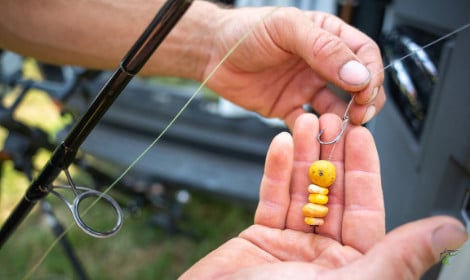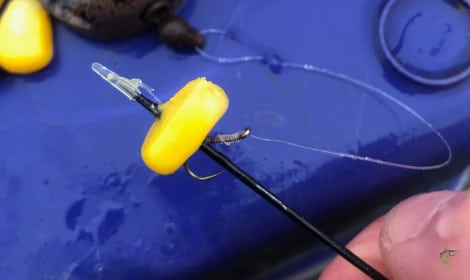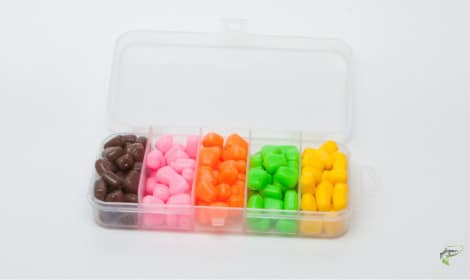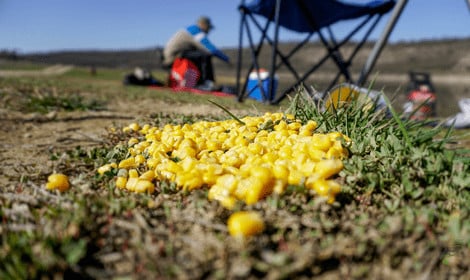
There is no doubt that sweetcorn is one of the best baits for catching carp and other coarse fish.
It’s probably the most versatile bait for carp fishing and other types of fishing in the sense it can be used in near enough all carp fishing approaches.
It can be mixed with pre-bait mixes to bring carp into a swim, used as a hook bait directly on the hook, used as a hair rigged bait, mixed with feeder mix or even fed on its own.
Its colour, high salt and sugar content and is naturally full of amino acids means the carp really find it hard to resist when they come across some sweetcorn underwater.
If you’re not already trying sweetcorn in your carp fishing approach, then it’s time you give it a go.
In this post, I’m going to focus on how to put sweetcorn on a hook and the various methods you can use to do so.
How to Put Sweetcorn On a Hook?
There are a few ways that you can put sweetcorn on a hook, but some are more effective than others.
Hair Rigged
Without a doubt, the easiest and most effective way to put sweetcorn on a hook is to hair rig the pieces. Hair rigs are relatively modern carp fishing rigs and were first invented and tested in the 1980s.
Hair rigs are methods of attaching bait to your rig without directly adding the bait to the hook. Carp are inquisitive and will investigate any food they deem may be edible.
They will sometimes suck the bait into their mouths to taste it and see if it reacts naturally in the water.
Hair rigs allow the hook to turn and move freely, and there is less chance the carp will eject the food as the bait should act more naturally in the water.
Hair rigs also allow you not to cover any of the hooks, so your hook is far more likely to set properly if a hungry fish plucks your bait from the bottom.
Now, let’s get into how to attach sweetcorn to a hair rig.
You’ll need a baiting needle for this, and make sure you pick large pieces of corn from the tin to help avoid them splitting and ripping from the hair rig once you push the bait stop through them.
1. Push the bait stop of your hair rig over the end of the baiting needle.
2. Take one (or a few) large pieces of corn from the tin.
3. Push the bait stop and needle through the centre of the corn carefully.
4. Pull the bait stop off the end of the baiting needing and place it horizontally over the top of the sweetcorn so it can’t slip back through the hole you’ve made
5. Job Done
Directly on the Hook
If you’re not a fan of hair rigs or want something simpler, you can directly hook the sweetcorn onto the hook. Although easier, this comes with downsides.
It is far easier for nuisance fish to pick away at sweetcorn directly on a hook and work it loose which is the last thing we want.
When using sweetcorn with a lot of nuisance fish in the water, it’s a good idea to check your rig often and recast to ensure the sweetcorn is still in place.
When directly hooking corn, you can take steps to ensure you are attaching the corn in the most effective way.
To do this, pierce the corn through the rounded end and work the corn around the hook until it pierces out of the flat bottom. This means your sweetcorn will be as secure as it can be on the hook.
If you choose to put sweetcorn directly onto the hook, make sure you leave a little of the hook point exposed. If not this can mean that it is likely that your hook won’t set if a carp picks up your bait and decides to spit it back out again.
Types of Sweetcorn
There is also a few types of sweetcorn that you can use as hook baits that all provide their own benefits.
We’ll take a look at some of these below so you can pick what’s right for your fishing approach.
Dedicated Fishing Sweetcorn
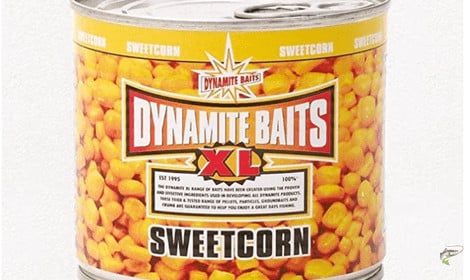
Although sweet corn from your local shop is great for carp fishing, there is a good selection of sweet corn made specifically for carp fishing. So are these just the same? No, not really.
If you are willing to fork out a little extra for a tin, then these tins could add an extra edge to your carp fishing and help you get a few more fish on the banks.
The corn in these tins is far larger than normal shop-bought sweet corn, making it a lot easier to get them on a hair rig or hook.
The bigger size may encourage more fish to feed and help discourage the smaller nuisance fish in your swim.
These specifically made tins will also have high sugar and salt content for added attraction in the water.
Imitation Corn
Imitation corn is another type of sweet corn used for hook baits. These aren’t sweetcorn at all and are just plastic-shaped like corn.
They come in varying colours and sizes, and the main benefit of these is that they won’t fall off the hook or hair rig easily.
A downside to this type is the lack of natural attractants such as the sugar, salt and amino acid in real corn.
If you choose to use this type, it is best paired with attractive baits like boilies and pellets on a hair rig.
Feed Corn
Feed corn is much larger than regular corn and lasts much longer if left outdoors. You can buy huge bags of this from your local feed store at very economical rates. In short, it is even cheaper than the corn that people buy for themselves.
You’ll need to boil it or soak it in water for half a day to make it soft enough to put on the hook. So, if you’re planning on using feed corn as bait, plan a few days ahead.
This type of corn is best used as pre-bait as it is cheap to use, and all the kernels of corn will be of varying sizes.
If you find large pieces, they can still be used as hook bait.
That’s All
Using sweetcorn can be one of the most effective hook baits on the market. It’s easily acceptable, cheap and can be used in all fishing approaches, so it can pay to always carry a tin to every fishing session.
I’m sure you can now see how simple it is to attach sweetcorn to a hook. If you have any questions, don’t hesitate to leave a comment below, and I’ll get back to you ASAP.

